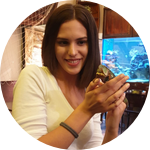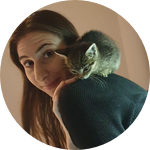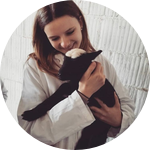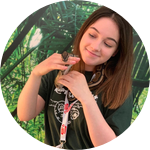About This Project
Mast cell tumors (MCTs) are the most common malignant skin tumors in dogs (Garrett, 2014.), and their behavior is largely determined by their histopathological grade (cell appearance under a microscope). So far this has been done manually by veterinary pathologists. But, such methods can be time-consuming and subjective. Therefore, it is important to develop an inexpensive and scalable solution that can enable pathologists to grade mast cell tumors faster and more objectively.
Ask the Scientists
Join The DiscussionWhat is the context of this research?
Because of the high incidence of MCTs in dogs, their variable biological behavior, and the potential fatal outcome, accurate prognostication of MCTs is critical.
The diagnosis of MCTs is based on skin biopsies. A sample of affected tissue is evaluated and graded by a veterinary pathologist based on the number of mitotic figures, multinucleated cells, bizarre (atypical) nuclei , and presence of karyomegaly (enlarged cell nucleus) (Kiupel et al., 2010).
Deep learning is a fast-growing field that offers novel perspectives for the automation of medical image analysis. It is widely believed that, by automating routine tasks and quantifying various diagnostic parameters, Deep Learning algorithms will lead to one of the biggest transformations in pathology (Colling et. al., 2019).
What is the significance of this project?
By building a deep learning model that will be able to automate histopathological grading, we can make mast cell tumor diagnosis not only faster but also more objective. This will lead to more accurate diagnoses in the future.
Also, with this project, we want to help create a new generation of veterinary pathologists that will have the skills and intrinsic motivation to do the whole end-to-end process needed for creating deep learning models. This is the most sustainable and scalable solution.
What are the goals of the project?
Our main goal is to create a deep learning model for canine cutaneous mast cell tumors histological grading. The model will need to be able to detect and count the number of mitoses, multinucleated cells, bizarre nuclei, and the presence of karyomegaly with >90% accuracy. We also want to develop and open-source a database consisting of at least 10 completely annotated whole slide images (WSI) of canine cutaneous mast cell tumors.
During this process, we will also build two improved versions of our low-cost microscope slide scanner and test not only their hardware capabilities but, more importantly, how the idea of open, programmable hardware can help us build community with the skills and domain expertise needed for creating deep learning applications we need in veterinary histopathology.
Budget
We will use the funds to build and test two microscope slide scanners. This will allow us to scan and label needed histological specimens.
Endorsed by
 Project Timeline
Project Timeline
Building on our previous work, we will build and test two new, improved versions of our microscope slide scanner. As we are building everything from scratch with a lot of custom machined part, it will take us to April 30th to assemble and test everything.
With the completion of Marvin and all the testing done, our team will start to label the data. With labeled data, we can start training our neural network.
We will share our results by the end of July.
Mar 08, 2021
Project Launched
Mar 15, 2021
Mechanical design complete
Apr 30, 2021
Building and testing complete
Jul 31, 2021
Dateset and model created
Meet the Team
Affiliates
Team Bio
We are a small team of veterinary students from the Department of Pathology at the Faculty of Veterinary Medicine, University of Zagreb. We believe that, when it comes to deep learning, pathologists shouldn't only be there for image labeling, but they also need to have the skills to do the whole end-to-end process needed for creating deep learning models. Therefore, by putting a high emphasis on Python programming (and Linux), we are working towards building unique skills capabilities.
Krunoslav Vinicki
Krunoslav Vinicki is a fifth-year student at the Faculty of Veterinary Medicine, University of Zagreb. In 2018. he published one of the first research papers in veterinary medicine on using modern convolutional neural networks (CNNs) in veterinary medicine (Vinicki et. al., 2018). Since then, he has been working on the integration of these technologies in veterinary pathology.
Dora Machaček
Dora Machaček is a fifth-year student at the Faculty of Veterinary Medicine, University of Zagreb.
Paula Marin
Paula Marin is a fifth-year student at the Faculty of Veterinary Medicine, University of Zagreb.
Marina Marić
Marina Marić is a third-year student at the Faculty of Veterinary Medicine, University of Zagreb.
Dorotea Staklarević
Dorotea Staklarević is a third-year student at the Faculty of Veterinary Medicine, University of Zagreb.
Lana Mićković
Lana Mićković is a fourth-year student at the Faculty of Veterinary Medicine, University of Zagreb.
Antun Surjan
Antun Surjan is a fourth-year student at the Faculty of Veterinary Medicine, University of Zagreb.
Iva Lukrecia Lubina
Iva Lukrecia Lubina is a third-year student at the Faculty of Veterinary Medicine, University of Zagreb.
Dominik Sremic
Dominik graduated from the University of Zagreb. He works as a robotic engineer at Inetec
Lab Notes
Nothing posted yet.
Project Backers
- 16Backers
- 22%Funded
- $1,110Total Donations
- $69.38Average Donation









